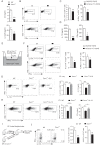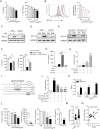CXCR1 drives the pathogenesis of EAE and ARDS via boosting dendritic cells-dependent inflammation
- PMID: 37709757
- PMCID: PMC10502121
- DOI: 10.1038/s41419-023-06126-y
CXCR1 drives the pathogenesis of EAE and ARDS via boosting dendritic cells-dependent inflammation
Abstract
Chemokines secreted by dendritic cells (DCs) play a key role in the regulation of inflammation and autoimmunity through chemokine receptors. However, the role of chemokine receptor CXCR1 in inflammation-inducing experimental autoimmune encephalomyelitis (EAE) and acute respiratory distress syndrome (ARDS) remains largely enigmatic. Here we reported that compared with healthy controls, the level of CXCR1 was aberrantly increased in multiple sclerosis (MS) patients. Knockout of CXCR1 not only ameliorated disease severity in EAE mice but also suppressed the secretion of inflammatory factors (IL-6/IL-12p70) production. We observed the same results in EAE mice with DCs-specific deletion of CXCR1 and antibody neutralization of the ligand CXCL5. Mechanically, we demonstrated a positive feedback loop composed of CXCL5/CXCR1/HIF-1α direct regulating of IL-6/IL-12p70 production in DCs. Meanwhile, we found CXCR1 deficiency in DCs limited IL-6/IL-12p70 production and lung injury in LPS-induced ARDS, a disease model caused by inflammation. Overall, our study reveals CXCR1 governs DCs-mediated inflammation and autoimmune disorders and its potential as a therapeutic target for related diseases.
© 2023. The Author(s).
Conflict of interest statement
The authors declare no competing interests.
Figures








Similar articles
-
IL-33 Deficiency Attenuates Lung Inflammation by Inducing Th17 Response and Impacting the Th17/Treg Balance in LPS-Induced ARDS Mice via Dendritic Cells.J Immunol Res. 2022 Dec 16;2022:9543083. doi: 10.1155/2022/9543083. eCollection 2022. J Immunol Res. 2022. PMID: 36570798 Free PMC article.
-
CC chemokine receptor 4 is required for experimental autoimmune encephalomyelitis by regulating GM-CSF and IL-23 production in dendritic cells.Proc Natl Acad Sci U S A. 2012 Mar 6;109(10):3897-902. doi: 10.1073/pnas.1114153109. Epub 2012 Feb 21. Proc Natl Acad Sci U S A. 2012. PMID: 22355103 Free PMC article.
-
IL-9 Controls Central Nervous System Autoimmunity by Suppressing GM-CSF Production.J Immunol. 2020 Feb 1;204(3):531-539. doi: 10.4049/jimmunol.1801113. Epub 2019 Dec 18. J Immunol. 2020. PMID: 31852750 Free PMC article.
-
MicroRNA223 promotes pathogenic T-cell development and autoimmune inflammation in central nervous system in mice.Immunology. 2016 Aug;148(4):326-38. doi: 10.1111/imm.12611. Epub 2016 Jun 29. Immunology. 2016. PMID: 27083389 Free PMC article.
-
Chemokines and chemokine receptors in autoimmune encephalomyelitis as a model for central nervous system inflammatory disease regulation.Front Biosci. 2004 May 1;9:1500-5. doi: 10.2741/1284. Front Biosci. 2004. PMID: 14977561 Review.
Cited by
-
IL-6 signaling accelerates iron overload by upregulating DMT1 in endothelial cells to promote aortic dissection.Int J Biol Sci. 2024 Aug 6;20(11):4222-4237. doi: 10.7150/ijbs.99511. eCollection 2024. Int J Biol Sci. 2024. PMID: 39247821 Free PMC article.
-
Genetically Designed Living Bacteria with Melanogenesis for Tumor-Specific Pigmentation and Therapeutic Intervention.Adv Sci (Weinh). 2024 Aug;11(31):e2402709. doi: 10.1002/advs.202402709. Epub 2024 Jun 18. Adv Sci (Weinh). 2024. PMID: 38889334 Free PMC article.
-
Serum biomarker-based risk model construction for primary Sjögren's syndrome with interstitial lung disease.Front Mol Biosci. 2024 Aug 21;11:1448946. doi: 10.3389/fmolb.2024.1448946. eCollection 2024. Front Mol Biosci. 2024. PMID: 39234569 Free PMC article.
-
Role of innate immune cells in multiple sclerosis.Front Immunol. 2025 Feb 17;16:1540263. doi: 10.3389/fimmu.2025.1540263. eCollection 2025. Front Immunol. 2025. PMID: 40034690 Free PMC article. Review.
-
A narrative review of chemokine receptors CXCR1 and CXCR2 and their role in acute respiratory distress syndrome.Eur Respir Rev. 2024 Jul 24;33(173):230172. doi: 10.1183/16000617.0172-2023. Print 2024 Jul. Eur Respir Rev. 2024. PMID: 39048127 Free PMC article. Review.
References
Publication types
MeSH terms
Substances
LinkOut - more resources
Full Text Sources
Molecular Biology Databases

